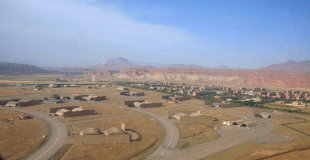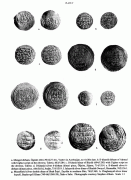Tabriz
 |
With a population of over 1.7 million (2016), Tabriz is the largest economic hub and metropolitan area in northwest Iran. The population is bilingual, speaking Azerbaijani and Persian. Tabriz is a major heavy industries hub for automobiles, machine tools, refineries, petrochemicals, textiles and cement production industries. The city is famous for its handicrafts, including hand-woven rugs and jewellery. Local confectionery, chocolate, dried nuts and traditional Tabrizi food are recognised throughout Iran as some of the best. Tabriz is also an academic hub and a site for some of the most prestigious cultural institutes in Northwest Iran.
Tabriz contains many historical monuments, representing Iran's architectural transition throughout its deep history. Most of Tabriz's preserved historical sites belong to Ilkhanid, Safavid and Qajar. Among these sites is the grand Bazaar of Tabriz, which is designated a World Heritage Site. From the early modern era, Tabriz was pivotal in the development, movement and economy of its three neighboring regions; namely the Caucasus, Eastern Anatolia and Central Iran. In the modern era the city played a vital role in the history of Iran. As the country's closest hub to Europe, many aspects of early modernisation in Iran began in Tabriz. Prior to forced ceding of the Qajar dynasty's Caucasian territories to Imperial Russia, following two Russo-Persian Wars in the first half of the 19th century, Tabriz was at the forefront of Iranian rule over its Caucasian territories. Until 1925, the city was the traditional residence of the Qajar crown princes.
According to some sources, including Encyclopædia Britannica, the name Tabriz derives from tap-riz ('flowing hot'), from the many thermal springs in the area.
Other sources claim that in AD 246, to avenge his brother's death, king Tiridates II of Armenia repelled Ardashir I of the Sassanid Empire and changed the name of the city from Shahistan to Tauris, deriving from "ta-vrezh" ("this revenge" in Grabar). In AD 297, it became the capital of Tiridates III, king of Armenia. However, this story has a popular origin and no ancient source has recorded such event. This is based on accounts of Vardan Areveltsi, a 13th-century Armenian historian. Accordingly, the historical Armenian name for the city was Tavrezh (Թաւրէժ).
The Cambridge History of Iran points to a connection between the "ancient stronghold of Tarui-Tarmakisa" (or Tarwi-Tarwakisa), which existed in the 8th century BC, and the city of Tabriz, with Ernst Emil Herzfeld's Archaeological History of Iran also directly equating "Tarwakisa" with Tabriz; cf Proto-Iranian tr̥Hwáns (able to overcome). However, some researchers believe that Tabriz may be considered a pre-Iranian toponym.
Map - Tabriz
Map
Country - Iran
 |
 |
| Flag of Iran | |
The country is home to one of the world's oldest civilizations, beginning with the formation of the Elamite kingdoms in the fourth millennium BC. It was first unified by the Medes, an ancient Iranian people, in the seventh century BC, and reached its territorial height in the sixth century BC, when Cyrus the Great founded the Achaemenid Persian Empire, which became one of the largest empires in history and a superpower. The Achaemenid Empire fell to Alexander the Great in the fourth century BC and was subsequently divided into several Hellenistic states. An Iranian rebellion established the Parthian Empire in the third century BC, which was succeeded in the third century AD by the Sassanid Empire, a major world power for the next four centuries. Arab Muslims conquered the empire in the seventh century AD, which led to the Islamization of Iran. It subsequently became a major center of Islamic culture and learning, with its art, literature, philosophy, and architecture spreading across the Muslim world and beyond during the Islamic Golden Age. Over the next two centuries, a series of native Iranian Muslim dynasties emerged before the Seljuk Turks and the Mongols conquered the region. In the 15th century, the native Safavids re-established a unified Iranian state and national identity, and converted the country to Shia Islam. Under the reign of Nader Shah in the 18th century, Iran presided over the most powerful military in the world, though by the 19th century, a series of conflicts with the Russian Empire led to significant territorial losses. The early 20th century saw the Persian Constitutional Revolution. Efforts to nationalize its fossil fuel supply from Western companies led to an Anglo-American coup in 1953, which resulted in greater autocratic rule under Mohammad Reza Pahlavi and growing Western political influence. He went on to launch a far-reaching series of reforms in 1963. After the Iranian Revolution, the current Islamic Republic was established in 1979 by Ruhollah Khomeini, who became the country's first Supreme Leader.
Currency / Language
| ISO | Currency | Symbol | Significant figures |
|---|---|---|---|
| IRR | Iranian rial | ï·¼ | 2 |
| ISO | Language |
|---|---|
| KU | Kurdish language |
| FA | Persian language |

























